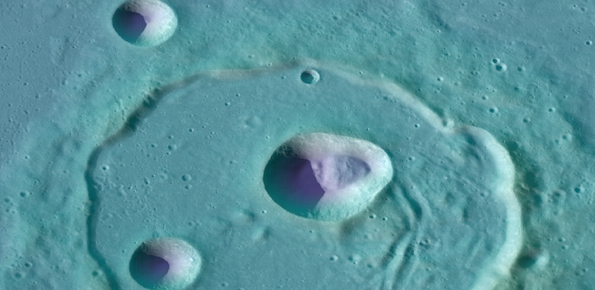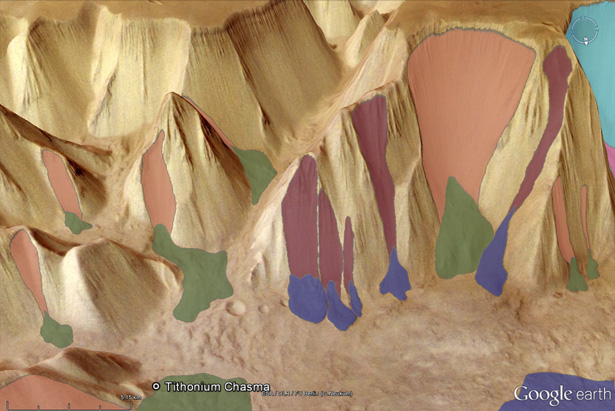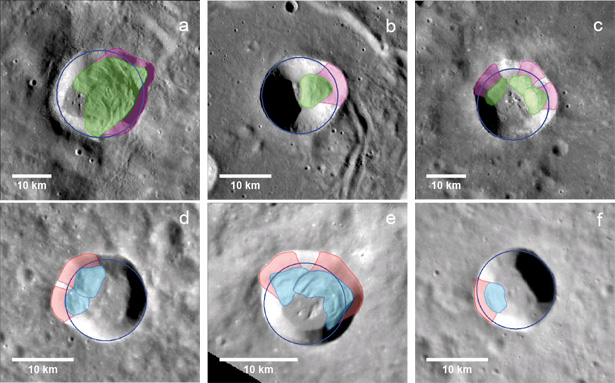Landslides in the Solar System
We map and study landslides in craters on the Moon and Mercury, and on the slopes of the Valles Marineris, Mars.

On Earth, landslides are hazardous phenomena often associated with economic damage and loss of human lives. The most common natural triggers of terrestrial landslides are intense or prolonged rainfall, earthquakes, rapid snow melting, and volcanic activity. But what are the main natural triggers of landslides on other solid bodies of the Solar System?
Since the early 70’s of the last century, landslides were observed on the surface of the Moon, Mars, Mercury and Venus, to mention only the bodies closest to the Earth. More recently, observations of the NASA’s Dawn probe (http://dawn.jpl.nasa.gov/) revealed that landslides are present on Vesta and Ceres, two asteroids.
The natural triggers of landslides on Earth may differ from the triggers of landslides on other solid bodies of the Solar System, because of different physical (e.g., gravity, atmospheric pressure) and environmental (e.g., presence or absence of fluids, erosion) conditions on the hosting environments.
We investigate the relationships between the presence of landslides and the physical and environmental conditions of solid bodies of the Solar System. Using the same criteria adopted to detect and characterize terrestrial landslides, we have identified, mapped and classified landslides on Mars, the Moon and Mercury, and we have compared the area, volume, length, and height of the extraterrestrial landslides with similar measures for terrestrial landslides.
Our aim is to understand how the physical properties of the materials on the planetary surface (e.g., the internal friction angle) affect the landslide trigger mechanisms.
On Mars, we mapped 189 landslides (Figure 1) in an area of 100,000 km2 in the Valles Marineris, a system of canyons 4000 km long, up to 200 km large, and up to 7 km deep, that stretches along the equator of Mars.
Figure 1: Geomorphological landslide inventory map for the study area in the Vallles Marineris, Mars. Scarp areas are shown in yellow, and landslide deposits are shown in different colors.
We classified the landslides in the Valles Marineris using the same landslide types used to map terrestrial landslides (Figure 2).
Figure 2: Examples of debris flow (landslide scarps in red and deposits in blue) and rock avalanches (landslide scarps in brown and deposits in green).
We used our map of landslides in the Valles Marineris to determine the statistical distributions of geometrical variables characterizing the Martian landslides, including landslide area, volume, length, and height, and to compare the distributions with similar known distributions for terrestrial landslides.
We have also recognized and mapped landslides on the Moon and Mercury, focusing on landslides inside the impact craters. Overall, we mapped 60 landslides on the walls of 35 craters of the Moon, and 58 landslides on the walls of 38 craters of Mercury.
Figure 3 shows examples of landslides in the craters of the Moon and Mercury.
Figure 3: Examples of rock slides on the Moon (scarps in purple and deposits in green) and Mercury (scarps in red and deposits in light blue).
Results
Our statistical analysis of the geometric variables (area, volume, length, height,) of the landslides mapped in the Valles Marineis, on Mars, and the comparison with similar distributions for terrestrial landslides, revealed that:
- Martian rock slides are larger on average than similar terrestrial rock slides;
- The percent of very large landslides (with area larger than 10 km2) is significantly larger on Mars than on Earth;
- the relationship between the area and the volume of landslides on Mars is similar to the same relationship for terrestrial landslides;
- the relatively low value of the apparent friction angle obtained from the geometry of the Martian landslides is compatible with the presence of weak rocks on the surface of the planet.
Using the SSAP simulation program (www.ssap.eu) that evaluates the stability of slopes, we found that deep-seated landslides on Mars can be triggered only by seismic activity, whereas shallow landslides are compatible with the presence of water.
For craters of the same size, slopes in Lunar craters are more stable than slope in the craters of Mercury. We hypothesize that this is an effect of the lower surface gravity of the Moon (1.6 ms-2) compared to Mercury (3.7 ms-2).
To know more
Brunetti MT, Guzzetti F, Cardinali M, Fiorucci F, Santangelo M, Mancinelli P, Komatsu G, Borselli L. 2014. Analysis of a new geomorphological inventory of landslides in Valles Marineris, Mars. Earth and Planetary Science Letters 405: 156-168. DOI: 10.1016/j.epsl.2014.08.025.
Brunetti MT, Xiao Z, Komatsu G, Peruccacci S, Guzzetti F. 2015. Large rock slides in impact craters on the Moon and Mercury. Icarus 260: 289–300. DOI: 10.1016/j.icarus.2015.07.014.






 Contact person: maria teresa brunetti -
Contact person: maria teresa brunetti -